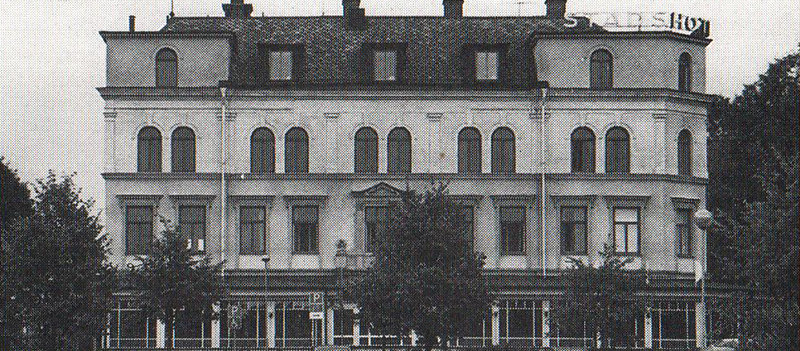Home » Our history
The phenomenon of Stadshotels emerged with the development of the Swedish railways at the end of the 19th century. The cities increased their business activities and with more travelers and visitors, more accommodation was needed. The street level of the hotels often housed a restaurant that became the natural hub of the city’s entertainment scene.

For over 100 years, our beautiful hotel has been a popular meeting place for both locals and travelers through the city on the shores of Lake Vänern. It all started in 1896, when Mayor Wennéus proposed that Lidköping, which at the time had two railways running through it, should build a modern and respectable hotel. Already in 1876, plans for a new hotel in the city had been discussed in the city council. But the issue remained unresolved for 20 years when a three-man committee was set up to examine the mayor’s proposal.
The already existing Hotel Lidköping was for sale at this time and the owner, Captain Bergmanson in Filsbäck, had asked for 50,000 riksdaler as a purchase price. A city hotel, which would be run by a manager on behalf of the city, was now coming into being.
But first it had to be given a contemporary look, so the Stockholm architect Nilsson-Dag was commissioned to make proposals for rebuilding it. The modernization was estimated at SEK 90,000, which was considered too expensive. With cheaper materials and some simplifications, the price was squeezed and the renovation took off. In 1900, the rebuilt hotel with a monumental building in the French Renaissance style was ready for its first guests. In 1933, the building was extensively modernized, including giving the facade its current appearance.
Lidköping received its first town charter in 1446. The town probably originated as a strategically located trading post where important routes to Skara, Norway and the west coast crossed.
In 1651, Jacob De la Gardie, Count of Läckö, was given Lidköping by Queen Christina. However, the town was returned to the Crown a few years later, but his son Magnus Gabriel was allowed to build a town within the county. After a land swap in 1670, construction began on De la Gardie’s own town plan. Lidköping then consisted of two small towns on either side of the river Lidan. The towns had separate mayors until 1683, when they were united into a single Lidköping under the Crown. De la Gardie watched over the two cities throughout his lifetime and today we can still sense his legacy in the names of streets, squares and buildings. The building on New Town Square was originally the Count’s hunting lodge.
Lidköping’s history has been marked by fires. In 1553 most of the city was destroyed and Sweden’s then King Gustav Vasa ordered the population to move to the place where Vänersborg is today (Huvudnäs), which never happened and the city was rebuilt instead. 300 years later, in 1849, a second fire destroyed virtually the entire old city. All that remained was the Limtorget neighborhood. To guard against further fires, most houses were then built in stone.
First student dinner
In 1950, Lidköping’s first students had dinner here at Stadshotellet. En kull på 15 gymnasister firade att de avslutat tre års studier på Lidköpings gymnasieskola, som öppnade 1947. The City Council attended, celebrated and had dinner with the happy students.
Taube on the ladies of the city
“Friendly hands, delicate fingertips and seemingly unloving”. This is how Evert Taube described the ladies of Lidköping in a letter written at the Stadshotellet one day in May 1947 when he was visiting the town. In the evening, he came back to the hotel and swung his furs to Forsberg’s Trio.
Successful banquet with Jussi
In 1944, the world-famous opera singer Jussi Björling visited the city to be a guest soloist at a concert. However, he was so ill on arrival that he had to go to hospital. Once there, miracles were performed, Jussi recovered and the concert was a success. The same goes for the subsequent banquet at the Stadt, where he received both cheers and gifts.
Steamy inauguration
In 1908, many guests almost missed their dinner at the Stadshotellet. When the Tunbanan was inaugurated, it was overlooked that even stationary trains consume steam. However, this was ingeniously solved by taking water from a ditch in Tun so that the party train could return to Lidköping in time for dinner.
Prenumerera på vårt nyhetsbrev för att ta del av nyheter och förmånliga erbjudanden.
© Lidköpings Stadshotell